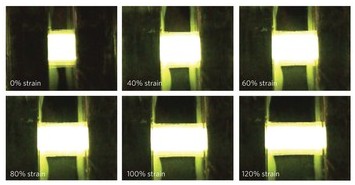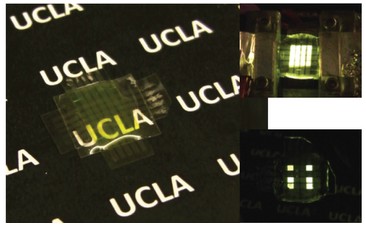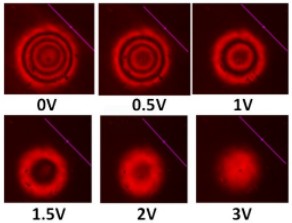一、本期重点:
doi: 10.1038/nphoton.2013.242
published:2013.9.22
内容介绍:
目前可拉伸显示器件的实现方案是在可拉伸的弹性高分子基底上嵌入诸多分立的LED或OLED。本文介绍了一种弹性可拉伸的高分子聚合物发光器件(EPLED),其本身在可拉伸弯曲等弹性形变基础上同时可完成发光。
EPLED有三层结构,电极层为银纳米线网状结构,中间层为聚氨酯丙烯酸酯(PUA)。这种EPLED对可见光的透明性和在室温下的弹性很好。它的线性拉伸可达原长度的120%,在30%的形变下可重复1000次的拉伸和松弛。
图一表现了这种EPLED的拉伸形变。图二是这种EPLED制作的显示设备模型,左侧大图可看到这种显示设备有很好的透明性,右侧两幅小图中每个发光的小方块区域代表1mm^2大小的像素。

图一 EPLED发光状态下的拉伸形变

图二 EPLED制作的显示设备模型
2.低压调制液晶透镜(Low voltage tunable liquid crystal lens)【Optics Letters】
doi: 10.1364/OL.38.004116
published:2013.10.9
内容介绍:
液晶透镜由于其焦距可调的特性在很多领域都有应用,但它的功耗、孔径、转换时间等仍是没有解决的问题。降低功耗的一种方法是调整液晶分子的预倾角度。一般液晶分子取向为垂直或水平,如果液晶分子本身即有水平到垂直间任意一种倾斜角度,则可降低调整液晶分子角度所需的能量。
文中使液晶分子产生预倾角度的方法是光配向法。光配向层的材料是Dai-Nippon Ink and Chemicals公司的CPL024。光配向层使得液晶分子的预倾角度范围达到了0-90度。图三是圆形透镜在不同电压下的透光情况。黑色圆环代表此环处的液晶分子取向不允许红光透过,随着电压增大,越来越多的液晶分子取向允许红光透过,由于分子取向的渐变性,透光的圆环逐渐融合,最终形成红斑。

图三 不同电压下圆形液晶透镜的透光情况
二、简讯:
doi: 10.1038/nphoton.2013.256
published: 2013.10.13
Abstract:
Optical materials with a dielectric constant near zero have the unique property that light advances with almost no phase advance. Although such materials have been made artificially in the microwave and far-infrared spectral range, bulk three-dimensional epsilon-near-zero (ENZ) engineered materials in the visible spectral range have been elusive. Here, we present an optical metamaterial composed of a carefully sculpted parallel array of subwavelength silver and silicon nitride nanolamellae that shows a vanishing effective permittivity, as demonstrated by interferometry. Good impedance matching and high optical transmission are demonstrated. The ENZ condition can be tuned over the entire visible spectral range by varying the geometry, and may enable novel micro/nanooptical components, for example, transmission enhancement, wavefront shaping, controlled spontaneous emission and superradiance.
2.介电交界面光子动量的增加和负光场力的实现(Linear momentum increase and negative optical forces at dielectric interface)
doi: 10.1038/nphoton.2013.192
published: 2013.8.11
Abstract:
Light carries momenta that can be transferred to objects. Relying on gradient forces created by structured light, one can trap and move microscopic particles. Aside from the conservative action of gradient forces, light always pushes an object along its direction of propagation. Here, we demonstrate that gradientless light fields can exert pulling forces on arbitrary objects in a purely passive dielectric environment and without resorting to non-paraxial illumination, interference of multiple beams, gain or other exotic materials. The forces acting against the flow of light arise naturally due to the appropriate amplification of the photon linear momentum when light is scattered from one dielectric medium into another with higher refractive index. This situation opens up a number of intriguing prospects for optical forces and their effects on surface-bound objects. Here, we demonstrate that this new mechanism can be used to manipulate objects over macroscopic distances along dielectric interfaces.
doi: 10.1364/OE.21.027074
published: 2013.10.31
Abstract:
A volumetric display that creates a distortion-free three-dimensional (3D) image in midair is described. The proposed system consists of rotating prism sheets used as an optical scanner and a dihedral corner reflector array (DCRA), which is a distortion-free imaging element. Two prism sheets are arranged in a symmetrical configuration to reduce an unnatural motion parallax caused by optical aberrations. A cross-section of the 3D image is formed by the DCRA in midair and moved by the rotating prism sheets to create a 3D displayable space. A 3D volume image was displayed without image distortion or unnatural motion parallax.
doi: 10.1038/ncomms3682
published: 2013.11.1
Abstract:
A configuration that shows great promise in sensing applications is vertically aligned piezoelectric nanowire arrays that allow facile interfacing with electrical interconnects. Nano-electromechanical systems developed using piezoelectric nanowires have gained interest primarily for their potential in energy harvesting applications, because they are able to convert several different sources of mechanical energy into useful electrical power. To date, no results have demonstrated the capability to use aligned piezoelectric nanowire arrays as a highly accurate nano-electromechanical system based dynamic sensor with a wide operating bandwidth and unity coherence. Here we report the growth of vertically aligned (~45 μm long) barium titanate nanowire arrays, realized through a two-step hydrothermal synthesis approach, and demonstrate their use as an accurate accelerometer. High sensitivity of up to 50 mV g−1 is observed from the sensor composed of vertically aligned barium titanate nanowire arrays, thus providing performance comparable to many of the commercial accelerometer systems.
供稿:王恒







